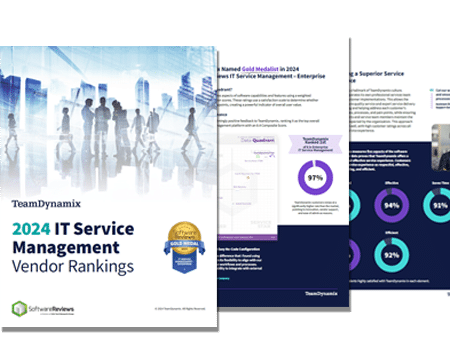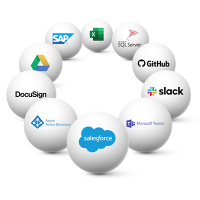
Companies Say They Need Automation, Easy-to-Manage ITSM
A study from Information Week and TeamDynamix shows companies are looking to invest in IT Service Management (ITSM) software that is simple to administer and

The Info-Tech ranking report offers a unique view of the market based entirely on in-depth customer interviews. Download the Info-Tech ITSM Quadrant and Customer Viewpoint report today.

We’ll show you some of our best situations and show you exactly how to execute them to get immediate results. The best part is, iPaaS tools often feature easy-to-use click and drag functionality, meaning you don’t need a dedicated employee building integrations and workflows.

System Integrators, Value Added Resellers, Technology Providers, and Buying Consortiums can benefit from a partnership with TeamDynamix.

The Info-Tech ranking report offers a unique view of the market based entirely on in-depth customer interviews. Download the Info-Tech ITSM Quadrant and Customer Viewpoint report to gain a better understanding of key vendor strengths and emerging market requirements.
Organizations with top-notch IT Service Management (ITSM) delivery are often successful because they focus on resource optimization. A great way to maximize your resources, especially when limited, is through self-service using Knowledge-Centered Service.
Knowledge-Centered Service (KCS) is a service method that focuses on knowledge as a key asset of your organization. By using KCS, you can scale and extend your support capabilities without needing additional staff or budget resources.
When using KCS, an organization focuses on creating and curating knowledge content that’s already being collected as part of its current troubleshooting and problem-solving efforts.
As the information is collected (whether through tickets, or other interactions) articles can be created in a knowledge base. This knowledge base can then be used for self-service. Meaning anyone having trouble can search the knowledge base for a resolution without needing to contact support.
By making the answers to your most asked questions or requests readily available in your knowledge base, your help desk and IT resources can focus their time on bigger, more complex problems.
Here are a few other ways KCS positively impacts an organization:
By adopting KCS, you can not only improve customer satisfaction but dramatically reduce the per-incident cost incurred by IT and reduce the volume of issues and requests coming to the help desk, allowing IT to reallocate technicians to higher priority tasks and projects.
Implementing Knowledge-Centered Service can involve a lot of moving parts. The following are six steps to help you get started:
Over the last few years, the University of South Dakota (USD) has been working hard to implement KCS best practices within its Information Technology Services (ITS) division. By collecting all information in a single, easily accessible knowledge base, ITS staff say they’ve been able to avoid a lot of repetitive work and improve their problem-solving capabilities. In addition, it’s reduced the amount of time it takes to train new ITS employees and has eased the burden on staff as more and more people use self-service to solve their problems.
“Early on, we saw an 18-percent reduction in time logged to service tickets,” Paula Cottrell, knowledge manager, said. “What would you do if you had an additional day a week?”
When USD had to shift to online instruction during the coronavirus pandemic, students and staff had many questions — and they could find answers to most of these at Coyote One Stop – the school’s branded knowledge base.
“With COVID, our hits went up tremendously,” Cottrell said. The university’s KCS methodology “allowed us to get new knowledge articles published quickly for people working [and learning] from home.”
Based on USD’s experience, Katharina Wymar, who heads the Project Management Office within ITS, and Cottrell shared these keys to success in implementing KCS:
For more information about USD’s journey, including how team members set and maintained standards for quality and consistency of articles, you can watch their KCS 101 session from TDX Converge, below, or read their Customer Spotlight, here.
This article was originally posted in February 2021 and has been updated with new information.

A study from Information Week and TeamDynamix shows companies are looking to invest in IT Service Management (ITSM) software that is simple to administer and

When it comes to improving IT Service Management (ITSM) maturity, many organizations turn to ITIL – a framework that guides users through a process-based approach

Enterprise Service Management (ESM) is the practice of extending IT Service Management (ITSM) principles beyond the IT department to other areas of an organization. ESM
TeamDynamix’s award-winning SaaS cloud solution offers IT Service and Project Management together on one platform with enterprise integration and automation.
[email protected]
(877) 752-6196
Contact Us
